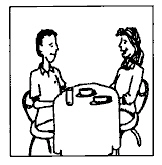IV. EstructurasA. Talking about Past Activities
En la playa.¿Qué hicieron las siguientes personas en la playa ayer?yo / ir a navegar
What will be an ideal response?
(Yo) fui a navegar.
You might also like to view...
Use el pretérito perfecto de subjuntivo o el pluscuamperfecto de subjuntivo de los verbos que mejor completen las siguientes oraciones.
Siento que tú _____________________________ enferma.
-_____ tu retrouves au restaurant ce soir? -Mes copains.
A. Qui est-ce que B. Qu'est-ce que C. Est-ce que
The Industrial Revolution refers to the social and economic changes that occurred when machines and factories, rather than human labor, became the dominant mode for the production of goods. Industrialization occurred in the United States during the early and mid-1800s and represents one of the most profound influences on the family. Before industrialization, families functioned as an economic
unit that produced goods and services for its own consumption. Parents and children worked together in or near the home to meet the survival needs of the family. As the United States became industrialized, more men and women left the home to sell their labor for wages. The family was no longer a self-sufficient unit that determined its work hours. Rather, employers determined where and when family members would work. Whereas children in preindustrialized America worked on farms and contributed to the economic survival of the family, children in industrialized America became economic liabilities rather than assets. Child labor laws and mandatory education removed children from the labor force and lengthened their dependence on parental support. Eventually, both parents had to work away from the home to support their children. The dual-income family had begun. During the Industrial Revolution, urbanization occurred as cities were built around factories and families moved to the city to work in the factories. Living space in cities was crowded and expensive, which contributed to a decline in the birthrate and to smaller families. The development of transportation systems during the Industrial Revolution made it possible for family members to travel to work sites away from the home and to move away from extended kin. With increased mobility, many extended families became separated into smaller nuclear family units consisting of parents and their children. As a result of parents' leaving the home to earn wages and the absence of extended kin in or near the family household, children had less adult supervision and moral guidance. Unsupervised children roamed the streets, increasing the potential for crime and delinquency. The relationship of the parts within the first sentence of the passage is a. time order. b. definition. c. clarification. d. example.
 Claude et Sylvie habitent et travaillent à Genève, en Suisse. Ils travaillent tous les deux dans de grandes entreprises. Le week-end, ils aiment s'amuser avec des amis et faire la cuisine. Ils viennent d'inviter quatre amis chez eux pour dîner samedi soir. Claude et Sylvie font les préparatifs.Click here for audio. Qu'est-ce qu'on sert? Écoutez la conversation entre Claude et Sylvie et complétez-la avec les mots que vous entendez.
Claude et Sylvie habitent et travaillent à Genève, en Suisse. Ils travaillent tous les deux dans de grandes entreprises. Le week-end, ils aiment s'amuser avec des amis et faire la cuisine. Ils viennent d'inviter quatre amis chez eux pour dîner samedi soir. Claude et Sylvie font les préparatifs.Click here for audio. Qu'est-ce qu'on sert? Écoutez la conversation entre Claude et Sylvie et complétez-la avec les mots que vous entendez.
Claude:Sylvie, qu'est-ce que tu (1) ____________________ manger samedi soir? Sylvie:Oh, je ne sais pas. Voyons. Marie (2) ____________________ et Étienne n'aime pas (3) ____________________. On peut manger (4) ____________________ peut-être? Claude:Oui. Bonne idée. Je vais (5) ____________________ et (6) ____________________. Sylvie:D'accord. Comme hors d'œuvre j'ai prévu (7) ____________________ de crevettes. Et comme (8) ____________________? Claude:Moi, j'aime (9) ____________________, mais Sophie et Yves (10) ____________________ les (11) ____________________. Sylvie:OK. Maintenant, je commence à (12) ____________________!(3) Fill in the blank(s) with the appropriate word(s).